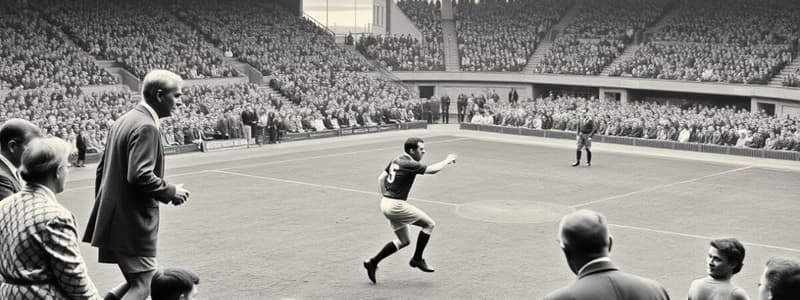Podcast
Questions and Answers
How did social class influence participation in sports and pastimes during Pre-Industrial Britain?
How did social class influence participation in sports and pastimes during Pre-Industrial Britain?
Social class in Pre-Industrial Britain was divided into upper class and lower class, and it influenced the types of sports or pastimes people were involved in. The upper class had more wealth and power, allowing them to participate in more sophisticated activities.
What were the two different terms used to describe the levels of social class in Pre-Industrial Britain?
What were the two different terms used to describe the levels of social class in Pre-Industrial Britain?
Upper Class and Lower Class.
What is the term that describes the two-tier class system during Pre-Industrial Britain?
What is the term that describes the two-tier class system during Pre-Industrial Britain?
The Feudal System.
How could the upper class develop and participate in more sophisticated activities?
How could the upper class develop and participate in more sophisticated activities?
How did social groupings and economic factors affect participation in pre-industrial Britain?
How did social groupings and economic factors affect participation in pre-industrial Britain?
Define Pedestrianism.
Define Pedestrianism.
Define Amateur in the context of sports.
Define Amateur in the context of sports.
Define Professional in the context of sports.
Define Professional in the context of sports.
How did law and order affect participation in sport during Pre-Industrial Britain?
How did law and order affect participation in sport during Pre-Industrial Britain?
How did gender, amateurism, and professionalism affect participation in Pre-Industrial Britain?
How did gender, amateurism, and professionalism affect participation in Pre-Industrial Britain?
Flashcards are hidden until you start studying
Study Notes
Social Class and Sports Participation in Pre-Industrial Britain
- Pre-Industrial Britain was characterized by a social class divide into Upper Class (aristocracy/gentry) and Lower Class (peasants).
- Social class determined participation in sports; the upper class engaged in more sophisticated activities while the lower class had simpler pastimes.
- Upper class activities, such as fox hunting and real tennis, required education, specialized facilities, and considerable financial resources.
Terms for Social Class
- Upper Class refers to hereditary landowners.
- Lower Class denotes peasants engaged in manual labor, primarily agriculture.
Two-Tier Class System
- The Feudal System defined the hierarchical structure of society, affecting various aspects, including sports participation.
Influences on Sports Participation
- Gender: Women participated in different activities; societal expectations limited their involvement, e.g., peasant women engaged in smock racing.
- Law & Order: Lack of formal law shaped violent activities (bare-knuckle boxing, animal baiting) favored by the lower classes.
- Education & Literacy: Upper classes enjoyed education and literacy, enabling them to understand complex rules for sports like real tennis. In contrast, peasants engaged in simpler games like mob football.
- Availability of Time: Longer working hours for lower-class peasants restricted leisure time; upper classes had more free time for sports.
- Availability of Money: Financial resources of the upper class facilitated greater involvement in diverse activities.
- Transport: Limited transport led to localized sports with simple rules known to local communities, intertwining work and leisure.
Key Definitions
- Pedestrianism: Nineteenth-century competitive walking, reflecting early organized sports.
- Amateur: An individual competing in sports without financial compensation, typically associated with the upper class who played for enjoyment.
- Professional: An individual earning an income through sports participation, often linked to the working class who could not afford to participate without financial gain.
Law and Order Impact on Sports Participation
- The absence of formal law during Pre-Industrial Britain influenced the nature of sports; lack of order led to violent pastimes (bare-knuckle boxing).
- Sports like mob football exemplified the chaotic nature of society and minimal regulation.
Effects of Gender, Amateurism & Professionalism
- Work and leisure were intertwined in PIB; agricultural demands dictated leisure time.
- The Industrial Revolution marked a shift, creating a clear division between work and leisure as factory jobs imposed long shifts and limited time for sports.
- The changing societal structure influenced access to, and participation in, various sports and pastimes.
Studying That Suits You
Use AI to generate personalized quizzes and flashcards to suit your learning preferences.




